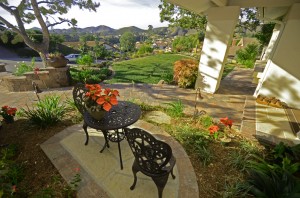We Treat Your Outdoor Space Like a Blank Canvas, Ready for Color
Proper plant selection is one the most important “secrets” in successful landscaping. Plants and colors are the “flavors” that bring your garden to life. They’re also elements that can be used with purpose such as screening, shade, erosion control, dividing, focal points, noise control, etc.
So choosing the right plants for the right place and purpose is helpful for professional looking, working, and manageable landscaping.
Growth Habits and Characteristics
First, there are some common mistakes that people make about plant selection. Usually this is simply because of a lack of knowledge of the growth habits and characteristics of individual plants. The size plants reach at maturity, light requirements, heat and wind tolerance, and soil preference are the most common. I can’t tell you how many times I’ve seen landscapes where massive trees or shrubs are growing within inches of a home or even worse, cracking the foundation of the home. These huge plants were planted when they were tiny little cute sprouts without any consideration given to the characteristics of the mature plant. This and all plant selection mistakes are usually the result of impulse buying (what looks pretty at the nursery) and a simple lack of planning and knowledge. The take-away from this is to not plan your garden or landscaping at the nursery or garden center. Hire a professional landscape designer who knows about plants and their characteristics and can tell what will and won’t work in your site. Another common mistake in choosing the right plants is made in the area of zoning.
It’s extremely important to know which planting zone you live in and plant accordingly. It’s amazing the number of nurseries and garden supply centers that carry plants that aren’t even zoned for their area. Now, some of these plants are great for placing outdoors in pots during the summer but they have to be moved indoors during the winter. Unfortunately nobody tells you that. It’s best to check with Scarlett’s Landscape Architect Design Team, who has extensive horticulture knowledge, to know what plants will work best in your zone.
These are the primary factors in growth habits and characteristics of plants:
- Height and Width: This is figured by the mature size a plant will reach in both upward and outward directions. Not calculating this can cause serious problems in the future.
- Form: This is the shape of the plant and how it will occupy and accent space. Form and shape are considered as columnar, round, vase, weeping, oval, creeping, etc.
- Texture: This is the fineness or roughness of plants. It can also be categorized in terms of leaf thickness and shade (light or dark) of plants. As a rule, plants with finer textures should be used in greater numbers than plants with coarse textures.
- Seasonal interest and color: This is figured by the special features a plant has at different times of the year. Foliage, fruit, flowers, winter color, changing colors, etc.
- Insect and disease resistance: This is important to consider if a particular plant is plagued by disease or common prey for a local pest
- Sun or Shade: All plants require a certain amount of sunlight during the day to thrive and remain healthy. This can vary from all day to none at all.
- Drought Resistance: This is the water amount and frequency that the plant requires. You’ll want to group plants with similar drought resistance.
- Soil Type: This is very important to consider and some plants require very well drained soil and won’t do well in clay. Some plants can tolerate all soil types.
Plant Selection is Key to Design & Visual Effect
 A few well-selected plant varieties can have more impact and appeal than a mix match selection of one of these here and one of those there. Unity is achieved in garden design by consistency.
A few well-selected plant varieties can have more impact and appeal than a mix match selection of one of these here and one of those there. Unity is achieved in garden design by consistency.
Planting in groups of 3’s, 5’s, 7’s, etc. also gives a sense of intentional design, balance, and unity.
Like I stated above, color is the “flavor” of your garden. Good color combinations and coordination can have a dramatic impact in garden design. So choosing plants that compliment or contrast with each other is essential.
Plant selection should also include plants of different bloom cycles. Use plants that bloom at different times to keep a splash of color in the garden all year. Use plants that are evergreen and semi-evergreen in equally spaced settings for added winter color and unity.
Give consideration to plant height. Obviously when creating striking color displays you want to keep small plants in front and larger plants in the back but plant height can also be used in creating natural focal points.
A Professional Design is the Way to a Harmonious Garden
As you can see, there is much to consider when selecting the plants and layout for your landscape. Take the guess work out of this experience and don’t put your investment at risk of failing to succeed. Let a Landscape Architect from Scarlett’s Landscape take your tastes and preferences and spin them into a web of interest and intrigue that can be enjoyed all year long.
Our Deep Roots of Experience in Planting are Your Advantage
Contact us now to discuss how we can bring those roots of wisdom to your outdoor living space.



